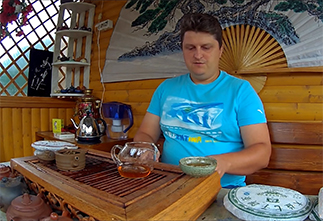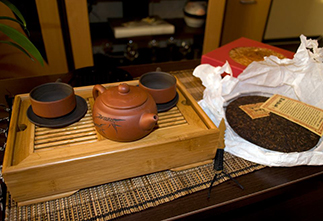The legendary exemplary shu puer, codenamed "701" from a famous tea factory with dense pressing and beautiful homogeneous raw materials.
When warmed up with your breath, you can feel the classic nutty-woody aroma with sweet notes of aged puer.
After washing, the aroma intensifies, a pronounced “Chen Xiang” shade appears, characteristic of old aged pu-erhs, closet-attic notes and a shade of dusty books.
The taste of brewed puer is clean, bright and moderately strong, nutty-chocolate with a classic pleasant and soft nutty bitterness characteristic of Tulin puers. During tea drinking, puer reveals notes of caramel, baked milk and prunes.
This pu-erh can be brewed in a Yixing clay teapot or in a gaiwan, observing the proportion of 8-10 grams per 100 ml.
The tea leaves a bright, refreshing aftertaste with chocolate tones, nuances of roasted hazelnuts and dry wood.
It warms you up perfectly, gives strength and energy, encourages action, and clarifies.
Shu puer 2013 "701" from the "Tulin" plant is an excellent high-quality pancake with a very successful and recognizable recipe. A wonderful gift for a tea lover.
|
Name in Chinese
|
普洱茶2013年土林701 400g |
|
Pinyin
|
Pǔ'ěr chá 2013 nián tǔ lín 701 400g |
|
Translation
|
Shu puer 2013 "701" of the Tulin plant 400 g |
|
Country
|
China |
|
District
|
Dali-Bay Autonomous Region |
|
Provinces
|
Yunnan (云南) |
|
Manufacturer
|
Тулинь (土林) |
|
Raw material production date
|
2013 |
|
Year of pressing
|
2013 |
|
Pressing form
|
Bing Cha (Cake Tea) |
- Комментарии
- Вконтакте
Pu-erh is one of the most unique types of tea, which only gets better with age. Many people, when they first encounter this tea, wondered: why is pu-erh more often found in pressed form (cakes, bricks, tochas), and not in loose form? The reasons for this are related to both history and the practical aspects of storing and fermenting tea. Despite modern technologies that allow the production of loose pu-erh, the shape of pressed cakes remains unchanged. And pu-erh is more often found on sale in pressed form, for example, in the form of cakes or bricks, and loose pu-erh is less common. We will talk about the reasons for pressing pu-erh into cakes in this article.
Puer is a unique Chinese tea that is distinguished by its depth of taste, complexity of aromas and versatility of aftertaste. Its taste characteristics are formed under the influence of many factors, from growing conditions to the brewing method. Let's look at the main ones.
The question often arises: how to brew puerh correctly? Sometimes the phrase "to get high" is added to it. Moreover, everyone has their own understanding of this phrase. Some mean vigor, and some - intoxication. So how to brew puerh tea correctly? Let's consider several options.
Traveling through the tea mountains, we found ourselves in another land of blue roofs - the village of Zhongcai, which is located in the Menghai district of Yunnan province. According to tradition, we were shown another local tea tree, which, according to the Chinese, is at least a million years old :) The village is very authentic, not designed for tourists, there are many wild pu-erhs there and, of course, we were warmly received. They treated us to local cuisine and tea. We also asked the residents about the prices of tea and how they have changed in recent years.
The tea ceremony occupies a special place in the centuries-old Eastern tradition. And although the essence of this phenomenon remains constant, the nature and external manifestations of the tea ceremony in different nations have their own national characteristics. In each Chinese province, the tea ceremony and the tea used in it are varied: for example, residents of the southern provinces prefer green tea, and residents of the northern provinces - red tea, in Fujian province they more often use Oolong tea, and in Yunnan province Puer tea is widely known.

























































































